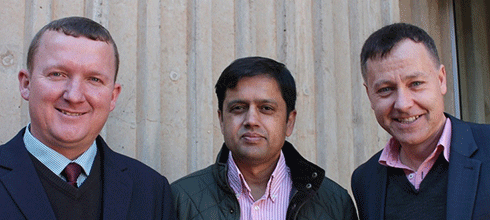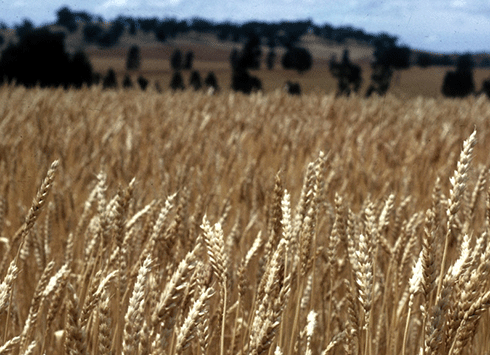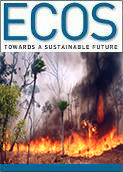
|
Published: 6 October 2014
Brad Ridoutt: measuring food’s water footprint
Dr Brad Ridoutt started his career as a forest scientist, before specialising in carbon and water footprinting. He uses a life cycle assessment (LCA) approach to assessing the complex connections between greenhouse gas emissions and water use in food manufacturing and agriculture.
Dr Ridoutt has helped develop a new international standard on water footprinting (ISO 14046) and has worked with food manufacturers, including the Mars group, to help them apply the water footprinting method he developed to their operations.
Q: By now, most of us have heard of terms such as carbon footprint and water footprint. What was the awareness of water footprinting like when you started to research and publish in this field?
A few years back, it was a very topical issue in much of Australia. There was a lot of data floating around the media, which were tending to use one particular definition or approach for water footprinting that myself and other colleagues disagreed with.
For example, most of us have come across claims about the water embodied in different foods such as meat and milk. They’re often shocking figures: 255 litres of water for a glass of milk, 15,000 or more litres per kilo for beef, and so on.
But water footprints shouldn’t just be summing up volumes of water used. It’s not just that figures such as this ignore where the water has come from (ie natural rainfall compared to irrigation) or what particular farming system has been used. It’s also that in some places, water resources are more available than in others. And if you don’t take that into account, then it doesn’t really have much context or meaning.
So the story behind water use in agricultural products is complex, and can’t be reduced to simple claims like this without greatly losing accuracy.
Q: Can you give an example?
Well, there is not much use in comparing grain grown in Australia without irrigation, and grain grown in parts of the world using irrigation that could be in highly water stressed regions, depleting underground water resources. The latter may seem to have a high water-use efficiency because the water delivered to the crop ensures very good production. In actual fact, it’s heading towards serious impacts for that community and the environment.
In contrast, most Australian cropping systems are rain-fed and there’s minimal interference with water resources. While they may have low yields by some international standards – because they’re mostly rain-fed – the farmers are very skilful in managing soil moisture and their properties in order to get high yields given available rainfall.
So if you don’t take these kinds of things into account, you end up with meaningless comparisons and ridiculous conclusions that float round in the media.
Q: How do you begin to account for that kind of complexity?
What is distinctive about water footprinting using the ISO standard is that the calculation involves the use of one or more impact assessment models to evaluate the environmental relevance of water use.
So, for example, water use in a highly water stressed environment would be considered differently and given greater emphasis than water use in a region of water abundance.
ISO 14046 also takes a life-cycle perspective, which means that water use along the production process is studied.
For example, with a dairying operation, the water footprint assessment considers not only the water use on farm, but also water used in production of farming inputs such as fertilisers or animal feed grown on other properties. It is important to identify where in the product system the greatest potential for environmental harm exists so that improvement efforts are focussed there
The new ISO standard represents the highest level international consensus on the subject. It took about 5 years to produce because of the 40-odd countries involved in developing it.
The need to reduce humanity’s water footprint doesn’t arise from an absolute shortage of freshwater in the world, but rather is the result of the current pattern of freshwater use, which is greatly skewed toward highly stressed watersheds.
Environmental relevance is the key to understanding water footprints and is a core principal of the new ISO standard. The standard specifies that you must conduct some level of impact assessment. One of the ways to do this is to use a ‘water stress index’. There are different water stress indices out there and some are better than others. Impact assessment methods are still in a state of evolution.
Q: What about the interaction between water and greenhouse gas emission impacts?
I work with companies to better understand their water and carbon footprints, and the journey often goes that companies start off with carbon footprints, then they move on to water footprint.
Then at some point, they end up with a situation where it’s difficult to improve one without impacting on the other, and often they go in reverse direction. They can work synergistically in some cases too.
In the field of life cycle assessment, the aim is to try to help to point towards interventions that are going to lead to an overall improvement.
For example, one way of [reducing] greenhouse gas emissions from livestock is to improve the quality of the feed to increase the growth rate. Animals become marketable at a younger age and therefore produce less methane over their lifespan. To do that, depending on where you are and what your different sources of feed may be, you may need to start feeding irrigated crops or irrigating pastures. So improving nutrition quality often means increased water use.
In another context, say a factory aiming to increase use of recycled or reused water, recycling water can be an energy-intensive process.
So often, you’ve got to be thinking of these things hand in hand and looking at things on a case-by-case basis.
A lot of people want a clear-cut, simple agenda but don’t realise that when it comes to implementing these things, often there are tradeoffs.

|
|
While many people are familiar with the concept of a carbon footprint, few think about the water footprint of the food and other products they consume. Credit: istock
|
Q: Does this work translate into consumer labelling in Australia?
In Australia, there is not much [footprint labelling] of products, full stop. Although people everywhere say how interested they are, there are very few footprint labels in the market.
Australian food exporters are most interested from the point of view of international market access.
In some international markets, these things have gone much further. In the European context, they’re developing a Product Environmental Footprint (PEF) and an Organisational Environmental Footprint (OEF). So in the case of products it will be a profile of footprints: which footprints will depend on which sector. In food, it will be a carbon footprint, a water footprint, and most likely something to do with land use or biodiversity.
With regard to footprints, it’s something that’s going to ramp up in years to come, because these environmental issues are only becoming more urgent and people are becoming more sensitised to them.
In the future, people will regard it as their right to have this information, to the same degree as we feel it’s our right to have access to nutritional information (does it contain nuts, what’s the added sugar content, etc).





